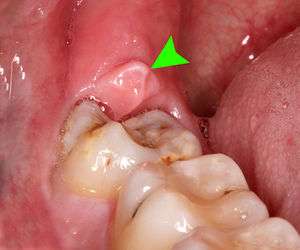Pericoronitis
Background
- Occurs during tooth eruption through the gingiva
- Food and bacteria can accumulate between the erupting tooth and operculum (flap of gingiva) leading to infection and pain
- The wisdom tooth (3rd molar) is the most common site of pericoronitis
Clinical Features

Pericoronitis
- Pain at site of recent tooth eruption with operculum
Differential Diagnosis
Evaluation
- Clinical diagnosis
Management
Mild to Moderate
- Analgesia (often requires dental block)
- Chlorhexidine rinses (a randomized trial showed green tea was equally effective)[1]
- Penicillin VK 500mg PO QID OR clindamycin 300mg PO QID
- ED debridement of the operculum or debris is usually not indicated
Severe
- Severe infections require intravenous antibiotics and admission
- Complications: Deep soft tissue infection
Disposition
Mild to Moderate
- Discharge with dental follow-up
- Refer to dentist for surgical excision of the operculum and/or removal of the offending tooth
Severe
- Admit
See Also
References
- Shahakbari R, Eshghpour M, Rajaei A, et al. Effectiveness of green tea mouthwash in comparison to chlorhexidine mouthwash in patients with acute pericoronitis: a randomized clinical trial. Int J Oral Maxillofac Surg. 2014;43(11):1394- 1398
This article is issued from
Wikem.
The text is licensed under Creative
Commons - Attribution - Sharealike.
Additional terms may apply for the media files.